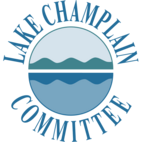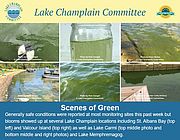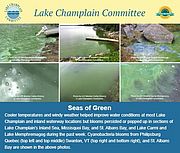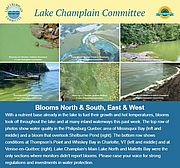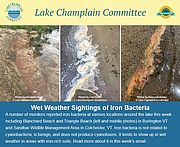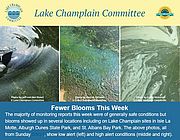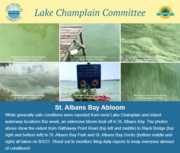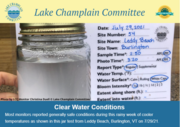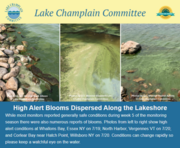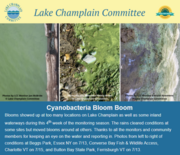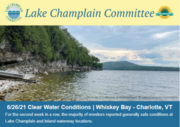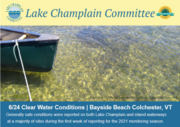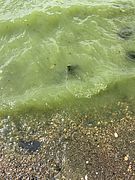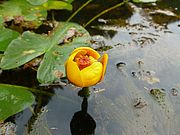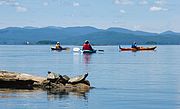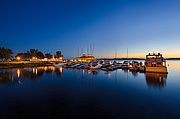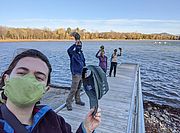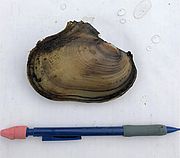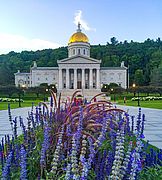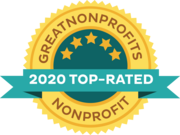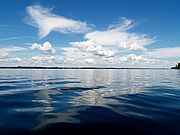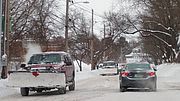Generally safe conditions prevailed at most locations again this week but cyanobacteria was reported at Lake Champlain’s Main Lake Central, Main Lake South, Missisquoi Bay, St. Albans Bay, and South Lake and at Lake Carmi and Lake Memphremagog. Read...
News from Selected Category
Windy, cooler weather helped improve water quality conditions during this eleventh week of monitoring. While generally safe conditions prevailed at most locations, cyanobacteria was reported at Lake Champlain’s Inland Sea, Missisquoi Bay, and St. Albans Bay as well as Lake Carmi and Lake Memphremagog. Read...
Cyanobacteria Monitors filed over 240 reports this past week as blooms popped up or persisted in numerous locations on Lake Champlain and several inland waterbodies. Lake Champlain’s Inland Sea, Main Lake Central, Main Lake South, Missisquoi Bay, South Lake, and St. Albans Bay all experienced blooms as did Chittenden Reservoir, Lake Carmi, Lake Iroquois, Lake Memphremagog, and Shelburne Pond. Read...
Happy Friday! Lots of green dots populated the cyanobacteria tracker this week and reports of clear water, non-filamentous green algae, and iron bacteria dominated over cyanobacteria in most areas. However, we did have cyanobacteria bloom reports from Lake Carmi and Lake Morey as well as Lake Champlain’s Inland Sea and low and high alert conditions at several St. Albans Bay sites as of today (8/20/21). Read...
Cyanobacteria monitors kept us busy again this week with 136 Lake Champlain reports and 43 from inland waterways. Blooms occurred in the Lake Champlain’s Inland Sea, Main Lake North, Malletts Bay, and St. Albans Bay as well as Indian Brook Reservoir and Lake Carmi as of this writing. Read...
We had many clear water reports early in the week but conditions changed in some areas as the temperatures rose and the air stilled later in the week. A bloom took off in St. Albans Bay, and alert conditions were witnessed elsewhere on Lake Champlain, Lake Carmi, and Lake Memphremagog. Read...
Happily water conditions improved significantly this week! Roughly 85% of the Lake Champlain reports and 94% of inland waterway reports showed generally safe conditions. Read...
Another busy week of monitoring with variable conditions up and down Lake Champlain. While most monitors reported generally safe conditions at Lake Champlain and inland waterway monitoring sites, low and high alert blooms were in evidence too. Lake Champlain’s St. Albans Bay, Inland Sea, Malletts Bay, Main Lake North, Main Lake Central, and Main Lake South, along with Indian Brook Reservoir and Lake Carmi, all experienced cyanobacteria blooms. Read...
Lake Champlain Committee (LCC) and community monitors filed a total of 246 reports this week as blooms showed up in a host of Lake Champlain shoreline and inland lake locations. Escalating temperatures spurred cyanobacteria growth that closed beaches at several lakeshore communities. Read...
Although generally safe conditions still dominate on the cyanobacteria datatracker, blooms showed up in several sections of Lake Champlain and Lake Memphremagog this week. Read...
While we received some reports of low alert cyanobacteria conditions on Lake Champlain and Lake Carmi, the majority of monitors observed generally safe conditions during this second week of the 2021 monitoring season. The cyanobacteria datatracker is populated with lots of green dots again this week. Yay! Read...
Monitoring began this week and will run through early fall. This week’s report covers conditions from Sunday, June 20 through early-afternoon on Friday June 25. The vast majority of reports we’ve received to date indicate generally safe conditions. Yay! Read...
Cyanobacteria blooms: Why do they happen, what are the risks, and what can we do?
Cyanobacteria blooms have received increasing attention in recent years, as a result of
particularly strong blooms in some areas. As research into blooms continues, we learn
more about what things make cyanobacteria blooms more likely, what dangers blooms
can pose to humans and other animals, and what the future might hold.
They touch the tips of swimmers’ toes, wrap around fish hooks, anchors, and paddles, and form underwater meadows near shorelines—native aquatic plants are ubiquitous in Lake Champlain Basin waterbodies. The roles these aquatic superstars play in lake ecosystems are often undervalued. It is not uncommon to hear native aquatic plants described as “yucky weeds”—let’s dispel this viewpoint! Read...
We have good news to share! Earlier this week--in response to opposition from the Lake Champlain Committee (LCC), the Vermont Natural Resources Council (VNRC), and the public--the Lake Champlain Transportation Company and Vermont Division for Historic Preservation announced they will not sink a retired ferry in Lake Champlain. Read...
Burlington, VT -- Citing opposition from environmental groups and the public, Lake Champlain Transportation Company and Vermont Division for Historic Preservation announced today the withdrawal of its application for a permit to sink the Adirondack, a retired ferry, in Lake Champlain. Instead of being abandoned underwater to create an artificial reef for scuba divers, the vessel will be scrapped. Read...
A virtual public meeting will be help on Tuesday, May 4th from 5:30 p.m. to 7:30 p.m. to discuss the Lake Champlain Transportation Company's proposal to sink the Ferry Adirondack in Burlington Bay. Please attend the meeting and speak out about why this decision is NOT right for Vermonters or for Lake Champlain. Read...
Out of concern for Lake Champlain’s underwater ecosystems, the Lake Champlain Committee (LCC) and the Vermont Natural Resources Council (VNRC) have appealed a permit issued by the Agency of Natural Resources (ANR) to allow the sinking of a 152-foot-long ferry near the Burlington waterfront. Read...
Happy Earth Day! Click here to read a few ideas for how to celebrate and protect our planet and the special corner we call home from your friends at the Lake Champlain Committee. Read...
Come work for clean water! The Lake Champlain Committee (LCC) seeks a highly-organized, detail-oriented, energetic, enthusiastic, multi-tasking Office Manager to work in a fast-paced team environment with humor, computer and web savvy, and a commitment to LCC’s mission. Database management and QuickBooks experience helpful. Equal Opportunity Employer. Read...
If you’ve paddled, taken a swim, or cast a fishing line in the waterbodies of the Lake Champlain Basin, you’ve likely spent time among one of the most enigmatic and imperiled groups of aquatic animals in our region: native freshwater mussels. They’re quirky—sporting hatchet-like shells and traveling by a single fleshy foot, yet familiar—related to the invasive zebra mussel and edible bivalves such as scallops. Read...
The Global Warming Solutions Act (GWSA) turned Vermont's climate emissions reductions goals into binding requirements and led to the creation of the Vermont Climate Council. The Council is in the early stages of developing a climate action plan to ensure we meet our emissions targets, prioritize our most vulnerable communities, and build a stronger, more resilient economy. Key to that effort is bringing in additional stakeholder perspectives and issues expertise through the Council's Subcommittees (see list below). Read...
Environmental leaders applaud Governor Scott’s commitment to funding increases for Vermont’s people, environment, and
economy. The proposed 2021 budget includes a boost to weatherization funding for low- and moderate-income households;
support for clean energy and transportation options; investments in our public lands; and improvements to our downtowns and village centers. Read...
Each year, the Vermont Clean Water Network hosts a Clean Water Policy Forum focusing on legislative and regulatory issues.
Register to hear Jared Carpenter, LCC's Water Protection Advocate, talk about the latest clean water issues under consideration in the current legislative session, and updates on Clean Water Service Providers and Vermont Agency of Natural Resources budgeting. Read...

Call to Action from Vermont Nonprofits in Response to January 6th
We share this message in response to recent violence and disruption to our democracy, both in our nation’s Capitol and across our country: Common Good Vermont unites nonprofits across Vermont to condemn actions of hate, violence, inciting of such actions, and disruptions to our lawful democratic processes. Vermont nonprofits stand united in opposition to the insurrection January 6th, on the U.S. Capitol, and its roots in white supremacy. Read...

LCC Statement on 1/6/21 Attack on the U.S. Capitol
The Lake Champlain Committee (LCC) strongly condemns the 1/6/21 attack on the United States Capitol. This assault on our democracy was an act of domestic terrorism. The actions were unpatriotic and unlawful. The stark contrast between how the mob of insurrectionists who vandalized the Capitol were treated and law enforcement response to peaceful Black Lives Matter protests in recent months underscores structural racism in our country. Read...
The Lake Champlain Committee (LCC) has been named a “2020 Top-Rated Nonprofit” by GreatNonprofits, the leading provider of user reviews and ratings of charities and nonprofits. The Top-Rated Nonprofit Award is based on the five-star ratings and reviews that LCC received from volunteers, donors and community members. Read...
In January of 2020, a coalition of 30 business, environmental, low-income, youth, public health, faith, and climate justice organizations including LCC identified the Global Warming Solutions Act (GWSA) as an essential priority for the 2020 Vermont legislative session. Nine months later, in late September 2020, GWSA officially became law after a veto by VT Governor Phil Scott was overridden by both the Vermont House and Senate. The legislation requires Vermont to reduce climate damaging emissions while simultaneously creating jobs, improving resilience, reducing energy burdens for rural and marginalized communities, and using natural systems to capture and store carbon. Read...
The Randy Preston Road Salt Reduction Act, a bipartisan bill that will help to reduce road salt pollution in the Adirondack Park, was signed into law by Governor Cuomo on December 2, 2020. The bill passed both houses of the New York Legislature in July with nearly unanimous support. The Adirondack Park contains more than 11,000 lakes and ponds, and over 30,000 miles of rivers, brooks, and streams. Lake Champlain forms the eastern border of the Park and a significant portion of the New York portion of the Lake Champlain Basin is within Park boundaries. Read...
Lake Champlain is home to 51 known non-native and aquatic invasive species (AIS), from zebra mussels and alewife to water chestnut and Eurasian watermilfoil, but not yet Asian clam. Invasive species are not native to the Lake Champlain Basin and can compete with native species for space and food, clog water intake pipes, and limit recreational activities. Read...
